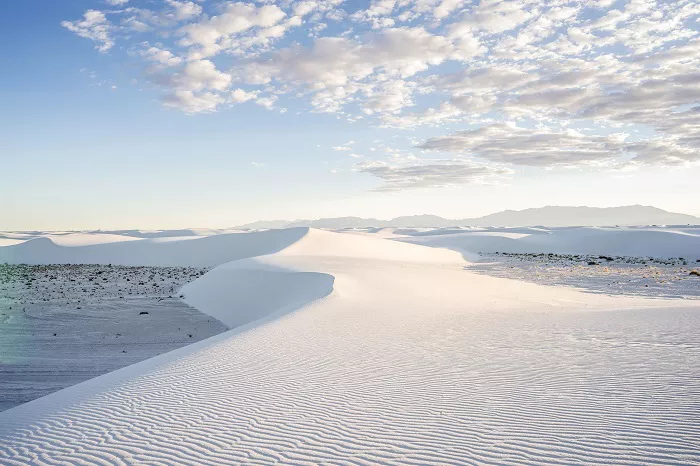White Sands National Park in southern New Mexico is a remarkable natural wonder. It features the world’s largest gypsum sand dune field, covering over 275 square miles. The park’s white sands create a unique and stunning landscape that attracts visitors year-round. However, the best time to visit White Sands National Park depends on various factors, including weather, activities, and personal preferences.
Spring: March to May
Weather and Conditions
Spring is considered one of the best times to visit White Sands. Daytime temperatures range from 70°F to 80°F (21°C to 27°C), with cooler nights averaging around 40°F (4°C). However, spring can bring strong winds, sometimes reaching up to 50 mph, leading to blowing sand and reduced visibility .
Activities
- Wildflower Viewing: Springtime brings blooming desert wildflowers, adding color to the white sands.
- Hiking and Sledding: The moderate temperatures are ideal for hiking and sand sledding.
- Photography: Clear skies and vibrant landscapes make for excellent photo opportunities.
Considerations
- Windstorms: Be prepared for sudden windstorms that can create white-out conditions.
- Crowds: Spring is a popular time, so expect more visitors, especially during weekends and holidays.
Summer: June to August
Weather and Conditions
Summers at White Sands are hot, with daytime temperatures often exceeding 100°F (38°C). The park experiences its rainy season from early July to late September, bringing afternoon thunderstorms .
Activities
- Early Morning or Evening Visits: To avoid the heat, plan activities during cooler parts of the day.
- Full Moon Hikes: Offered from March to November, these hikes provide a unique experience under the moonlight .
Considerations
- Heat Precautions: Carry plenty of water, wear sun protection, and avoid strenuous activities during peak heat.
- Storms: Be aware of sudden thunderstorms and seek shelter if lightning is present.
Fall: September to November
Weather and Conditions
Fall offers pleasant weather, with daytime temperatures ranging from 70°F to 80°F (21°C to 27°C) and cooler nights. The monsoon season tapers off, resulting in fewer storms .
Activities
- Hiking and Sledding: Comfortable temperatures make outdoor activities enjoyable.
- Photography: The changing light and fewer crowds provide excellent photography conditions.
Considerations
- Reduced Crowds: Fall sees fewer visitors, offering a more peaceful experience.
- Camping: Cooler nights are suitable for camping, but be prepared for chilly temperatures.
Winter: December to February
Weather and Conditions
Winter brings cooler days, with average highs around 60°F (16°C) and cold nights averaging 23°F (-5°C). Snow is rare but possible .
Activities
- Photography: The low angle of the sun creates dramatic shadows on the dunes.
- Quiet Exploration: Fewer visitors make for a serene experience.
Considerations
- Cold Nights: Overnight camping may be uncomfortable due to low temperatures.
- Limited Services: Some facilities may have reduced hours or be closed.
Monthly Overview
| Month | Avg High (°F) | Avg Low (°F) | Notes |
|---|---|---|---|
| January | 57 | 22 | Cold nights; quiet park |
| February | 63 | 27 | Cold nights; increasing daylight |
| March | 71 | 32 | Windy; blooming wildflowers |
| April | 79 | 40 | Pleasant weather; windstorms possible |
| May | 88 | 50 | Warm days; start of peak season |
| June | 97 | 59 | Hot; start of rainy season |
| July | 97 | 64 | Hot; frequent thunderstorms |
| August | 94 | 62 | Hot; monsoon season |
| September | 89 | 55 | Cooling temperatures; fewer storms |
| October | 79 | 41 | Ideal weather; fewer crowds |
| November | 67 | 28 | Cooler days; quiet park |
| December | 57 | 21 | Cold; minimal visitors |
Tips for Visiting
- Hydration: Always carry plenty of water, regardless of the season.
- Sun Protection: Use sunscreen, wear hats, and sunglasses to protect against the intense sun.
- Check Weather: Monitor forecasts for windstorms or thunderstorms.
- Plan Ahead: Check for any park alerts or closures before your visit.
- Clothing: Dress in layers to accommodate temperature changes throughout the day.
- Permits: Obtain necessary permits for activities like backcountry camping.
Conclusion
White Sands National Park offers unique experiences throughout the year. Spring and fall are generally considered the best times to visit due to mild temperatures and fewer weather-related challenges. Summer provides opportunities for special events like Full Moon Nights but comes with intense heat and potential thunderstorms. Winter offers solitude and excellent stargazing but requires preparation for cold temperatures. By considering the seasonal variations and planning accordingly, you can make the most of your visit to this extraordinary landscape.

